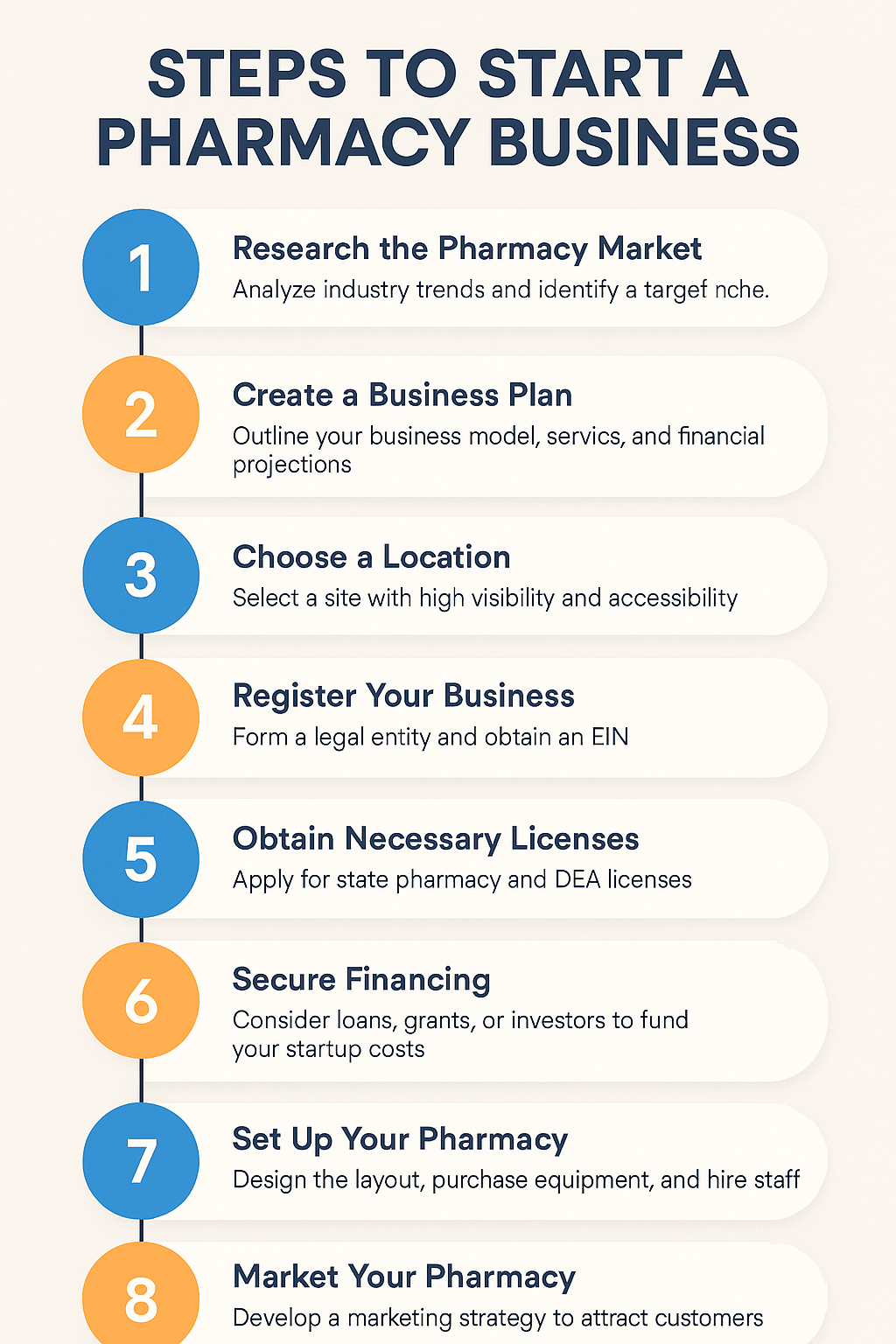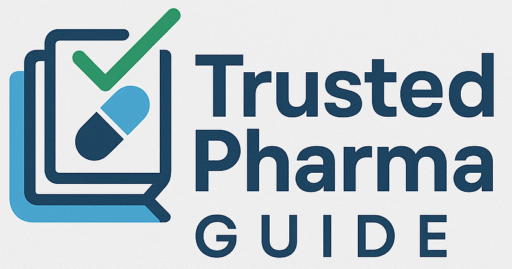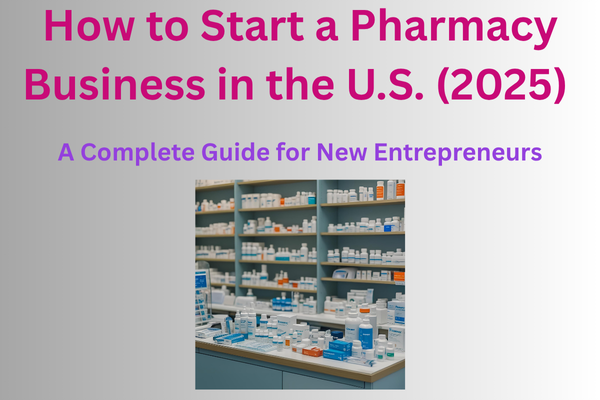Table of Contents
If you’re wondering how to start a pharmacy business, you’re not alone. With the growing demand for accessible healthcare, the pharmacy industry in the United States offers tremendous potential for aspiring entrepreneurs. Whether you’re a pharmacist or a healthcare investor, starting a pharmacy business can be both profitable and fulfilling – if done right.
This step-by-step guide will walk you through every aspect of starting a pharmacy in the United States, including planning, licensing, operations, staffing, marketing, and more.
1. Why Start a Pharmacy Business in the U.S.?
The U.S. pharmacy market is the largest and fastest-growing in the world. With more than 4 billion prescriptions filled each year and the number of people needing medication for chronic conditions increasing, there has never been a better time to start a pharmacy business.
Independent pharmacies are seeing a resurgence as patients seek personalized care, faster service, and community-based support—all of which are often lacking in larger chains. In this blog include step by step guide for how to start a pharmacy business.
2. Choose Your Pharmacy Business Model
The most important step in learning how to start a pharmacy business is choosing the right model:
• Retail Pharmacy – A walk-in pharmacy that dispenses medications, sells OTC products, and provides patient counseling.
• Compounding Pharmacy – Custom-formulates medications tailored to individual patients.
• Online or mail-order pharmacy – Delivers prescriptions directly to homes, often combined with telehealth services.
• Franchise Pharmacy – Opens under a brand name such as Health Mart or Good Neighbor Pharmacy.
• Long-term Care Pharmacy – Serves nursing homes, assisted living facilities, and long-term care centers.
💡 Focus Tip: A unique business model gives your pharmacy a competitive edge. Consider serving specific markets or combining wellness and preventive care.

3. Write a Business Plan for Your Pharmacy
How to start a pharmacy business includes, you need a solid business plan that explains how you will start, run, and grow your business.
Your business plan should include:
• Executive Summary
• Market Research and Target Demographics
• Competitor Analysis
• Pharmacy Layout and Workflow Design
• Services to be Offered (e.g., Immunizations, MTM, Home Delivery)
• Marketing and Advertising Plan
• Financial Forecast (Start-up and 3- to 5-Year Forecast)
• Break-Even and ROI Analysis
• SWOT Analysis (Strengths, Weaknesses, Opportunities, Threats)
If you are applying for a loan or investors, your business plan will serve as your pitch document.
4. Register Your Pharmacy Business
When learning how to start a pharmacy business, you must legally register it in your state.
Steps include:
• Choose a legal structure (LLC, S-Corp, or C-Corp)
• Register your business name
• Apply for an Employer Identification Number (EIN)
• Open a business bank account
Also, consult an accountant or business attorney to ensure you are complying with state and federal tax laws.
5. Obtain the Required Licenses and Permits
Licensing is the most complex but vital step in how to start a pharmacy business in the U.S.
Licenses You Will Need:
- State Pharmacy License (via your State Board of Pharmacy)
- DEA Registration – Required to dispense controlled substances
- NPI Number – Issued by the Centers for Medicare and Medicaid Services (CMS)
- FDA Facility Registration – Necessary for compounding or manufacturing drugs
- Business Operation License – Local or county-level
- Sales Tax Permit – Required in most states
- HIPAA Compliance Certificate – Ensures patient privacy and data protection
6. Secure Your Pharmacy Location
Your choice of location can make or break your business.
Ideal pharmacy locations:
• Near hospitals, urgent care clinics, or doctors’ offices
• Inside medical complexes or strip malls
• Rent or purchase property in a rural or suburban area that is zoned for medical use and make sure it meets DEA and state pharmacy board space and safety requirements.
7. Raise Capital for Startup Costs
It is estimated that starting a pharmacy in the United States can cost anywhere from $250,000 to $600,000, depending on the model and size.
Common Costs:
• Lease or Real Estate
• Pharmacy Management System
• Inventory and Equipment
• Licensing and Insurance
• Staffing and Payroll
• Marketing and Branding
Funding Sources:
• SBA Loans (Small Business Administration)
• Healthcare Financing Companies (Live Oak Bank, First Financial Bank)
• Private Investors
• Pharmacy Franchises (some offer low-cost setups)
• Personal Funds or Family Contributions
8. Set Up Pharmacy Infrastructure
Your pharmacy should have an efficient workflow and a professional layout.
Areas to be covered:
• Prescription counter and dispensing area
• Medication storage (including refrigerated medications)
• Counseling room (for MTM or immunizations)
• Waiting area
• Inventory room
• Office and break room
Equipment to be covered:
Pharmacy management software (PMS)
• POS system with EMV card reader
• Barcode scanner
• Pill counter and label printer
• Computer and security system
• Refrigerator and temperature monitors
9. Hire Qualified and Licensed Staff
Staffing is one of the key steps in how to start a pharmacy business successfully.
Core Pharmacy Staff:
- Pharmacist-in-Charge (PIC)
- Pharmacy Technicians
- Billing and Insurance Coordinator
- Delivery Personnel (for home delivery services)
- Cashiers and Front Desk Assistants
Hire individuals with experience, proper certifications, and a customer-focused mindset.
10. Partner with Drug Distributors and PBMs
You need to have relationships with licensed drug wholesalers and pharmacy benefit managers (PBMs) to operate smoothly.
Leading U.S. Distributors:
- McKesson
- Cardinal Health
- AmerisourceBergen
- Anda
Apply for a DEA Form 222 for controlled substances. Join pharmacy buying groups to get better pricing and rebates.
Also, enroll in PBM networks to process insurance claims and reimbursements efficiently.
11. Choose the Best Pharmacy Software
Your pharmacy software should integrate inventory management, prescription filling, reporting, and insurance claims.
Popular Pharmacy Management Systems in 2025:
- PioneerRx
- Liberty Software
- PrimeRx
- McKesson Pharmacy Systems
- QS/1 NRx
🔍 Pro Tip: Choose a cloud-based solution with e-prescribing, eMAR, and real-time analytics.
12. Develop a Marketing Strategy
Your marketing plan is crucial to launching and sustaining your pharmacy.
Marketing Ideas:
• Launch a pharmacy website with online refill and delivery features
• Google Business Profile for local SEO
• Email marketing with health tips and reminders
• Facebook and Instagram ads targeting local zip codes
• Host free health camps or vaccination drives
• Loyalty and referral programs
🎯 Bonus Tip: Run monthly promotions like “Senior Day Discount” or “Free Vitamin Samples with Refills.”
13. Maintain Compliance and Quality
Pharmacy laws must be followed to avoid fines and build trust.
Key compliance areas:
• HIPAA privacy and data protection
• OSHA safety standards
• Controlled substance recordkeeping
• Regular inventory audits
• Ongoing employee training and CE credits
Join NABP’s Verified Pharmacy Program (VPP) to demonstrate your credibility.
14. Focus on Patient-Centered Services
In today’s competitive marketplace, it’s essential to go beyond prescriptions. Expand your services to:
• Medication Management (MTM)
• Immunizations and Vaccinations
• Health Screenings (Cholesterol, Diabetes)
• Home Delivery and Curbside Pickup
• Medication Synchronization Programs
These services increase patient satisfaction and retention.
Conclusion: Build a Successful Pharmacy That Serves and Grows
Understanding how to start a pharmacy business involves more than just obtaining licenses and finding a location. It requires foresight, planning, compliance, staffing, technology, and community involvement. With the right strategy and a commitment to patient care, you can build a pharmacy that is not only profitable but also trusted by your community.
Your journey into pharmacy entrepreneurship can be challenging – but incredibly rewarding. Get started today by creating a clear business plan and taking one step at a time toward starting the pharmacy of your dreams.
Frequently Asked Questions (FAQs)
1. How much does it cost to start a pharmacy business in the U.S.?
2. Do I need to be a pharmacist to start a pharmacy?
3. What licenses are required to open a pharmacy?
State pharmacy license (from your State Board of Pharmacy)
DEA registration
NPI number
Business license
FDA registration (if compounding)
Sales tax permit
Each state may have different rules, so always check local requirements.
4. How long does it take to start a pharmacy?
5. Can I open an online pharmacy in the U.S.?
6. How can I make my pharmacy business profitable?
Focus on excellent customer service
Offer services like immunizations and MTM
Use automation and pharmacy software to reduce errors
Join buying groups to reduce inventory costs
Accept insurance and enroll with PBMs
Build relationships with local doctors and clinics
7. What is the best location to open a pharmacy?
Underserved communities
Near hospitals or clinics
Medical office buildings
Rural areas with limited access
Choose areas with good foot traffic, minimal competition, and a strong need for healthcare services.
8. What kind of insurance does a pharmacy need?
General liability insurance
Professional liability (malpractice) insurance
Workers’ compensation
Property insurance
Cyber liability insurance (for digital records)
These policies protect your business from legal claims, property damage, data breaches, and more.

